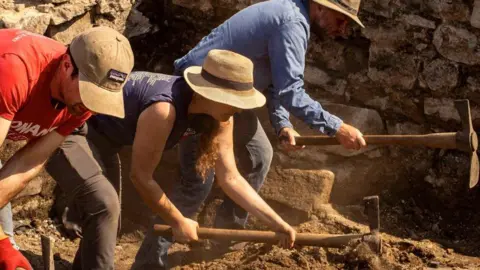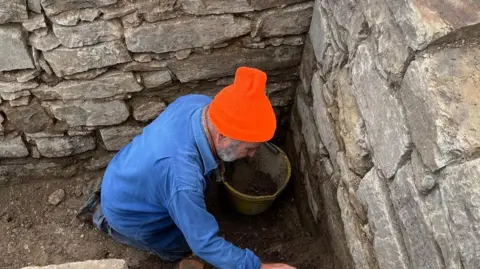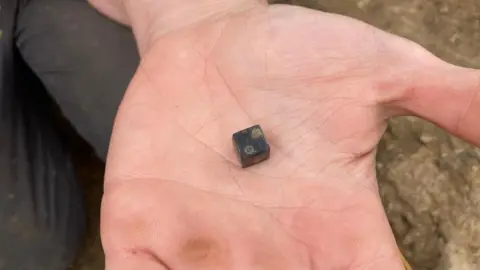Fortune-telling die among castle's quirky finds
 Alexander Jansen/Durham University
Alexander Jansen/Durham UniversityA medieval toilet and a jet die used to predict the future were some of the findings that could help build a picture of everyday life at a medieval bishop's palace.
Archaeologists at Auckland Castle in Bishop Auckland, County Durham, finally put down their trowels last Friday, ending more than seven years of excavations at the site.
A detailed analysis of the findings, which could take up to two years, is currently under way.
The final summer of digging culminated with the discovery of a huge medieval wall, but other interesting objects - from mundane to magical - have also been found since 2018.
Medieval toilet
At least three medieval toilets have been found over the years "dotted around the site" according to John Castling, the Auckland Project's archaeology curator.
"One is ironically very near to where the toilets are now for our visitors," he said.
The latest one was found in June.
The facility, known as a garderobe, is next to the Great Hall, where the bishops and their guests would have feasted.
 Durham University/The Auckland Project
Durham University/The Auckland ProjectIt might not seem particularly hygienic today, but at the time it was a "much cleaner way" than most people had in their houses, Mr Castling said.
"It's demonstrating the power and importance of the bishops and their households."
It is believed the toilets were last used in the 13th Century.
Whale baleen
 Durham University/The Auckland Project
Durham University/The Auckland ProjectDescribed as one of the most "rare and unusual" findings at the site, a whale baleen was discovered "sandwiched" between off cuts of 17th Century glass.
Baleen is found inside the mouths of some whale species and is used instead of teeth to help filter prey.
If a whale washed up on a nearby shore, it was claimed by the bishop as a token of their semi-regal status but also as a resource, Mr Castling said.
The baleen was used in a similar way to modern day solid plastics and was put in items such as corsets, painting brushes and gauntlets.
"In the modern world we tend to think of whales as beautiful creatures that are not a resource," Mr Castling said.
"But in the medieval period they were viewed with a degree of reverence, but they were also seen as a resource that could be used if it washed up on the shore."
Fortune-telling die
 Durham University/The Auckland Project
Durham University/The Auckland ProjectA jet die was also found, but it was not used to play games.
Instead, in the medieval period people believed the item could help predict the future.
Mr Castling said there were not many similar dice in the UK and most were found in religious sites.
When rubbed, jet sparks and gives off static.
"When you first say to people, they had dice which they used in order to try and discern the future, that sounds completely alien to our modern rational world," Mr Castling said.
"But it produces something that feels magical."
European objects
 Durham University/The Auckland Project
Durham University/The Auckland ProjectSome items at the site have travelled from further afield.
Archaeologists have found a 17th Century knife, believed to have come from Amsterdam, as well as French jettons, coin-type objects used in calculations.
An amphora though to originate from south-west Spain was also discovered last summer.
